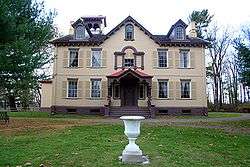Martin Van Buren National Historic Site
|
Lindenwald Martin Van Buren National Historic Site | |
 Front of the house facing the Albany Post Road | |
  | |
| Location | Town of Kinderhook, Columbia County, New York |
|---|---|
| Nearest city | Kinderhook, New York |
| Coordinates | 42°22′10.94″N 73°42′15.14″W / 42.3697056°N 73.7042056°WCoordinates: 42°22′10.94″N 73°42′15.14″W / 42.3697056°N 73.7042056°W |
| Area | 125 acres (51 ha) |
| Built | 1841 |
| Architect | Peter Van Ness; Richard Upjohn |
| Architectural style | Federal; Gothic Revival |
| Visitation | 13,617 (2004) |
| Website | Martin Van Buren National Historic Site |
| NRHP Reference # |
66000510 (original) 12000406 (increase) |
| Significant dates | |
| Added to NRHP | October 15, 1966[1] |
| Boundary increase | July 11, 2012[2] |
| Designated NHL | July 4, 1961[3] |
| Designated NHS | October 26, 1974 |
Martin Van Buren National Historic Site is a unit of the United States National Park Service located 20 miles (32 km) south of Albany, New York, or two miles south of the village of Kinderhook, New York in Columbia County. The National Historic Site preserves the estate and thirty-six room mansion of Martin Van Buren, the eighth President of the United States. Van Buren purchased the estate, which he named Lindenwald, in 1839 during his one term as President and it became his home and farm during his retirement.
History
Van Buren, a founder of the Democratic Party, purchased the home and approximately 125 acres (51 ha) of land in 1839 for $14,000 (equal to $314,869 today) while he was still President. However, Van Buren did not move into the home until 1841 (after he was defeated for his second term by the Whig candidate William Henry Harrison in 1840). Eventually, his four living sons, Abraham, John, Martin Jr., and Smith, had rooms in the mansion. The home was previously owned by the Van Ness family and was where Washington Irving wrote most of his book A History of New York. Irving and Van Buren later became friends.[4]
Van Buren ran two United States Presidential campaigns from Lindenwald. In 1844, he based his ultimately unsuccessful run for the Democratic nomination at the estate. That year, Van Buren lost a hotly contested fight to nominee and eventual President James Knox Polk. In 1848, in opposition to the extension of slavery into territories captured from Mexico as a result of the Mexican-American War, Van Buren ran for President on a third-party ticket (The Free Soil Party), again directing his campaign from Lindenwald. Van Buren's campaign drew enough votes away from the Democratic nominee, Lewis Cass, to allow Whig candidate Zachary Taylor to prevail.
Van Buren named the estate Lindenwald, which is German for "linden forest", after the American Linden (American Basswood or Tilia americana) trees lining the Albany-to-New York Post Road, which is still located in front of the home. The section of the road on the property remains unimproved to this day. Some replanted Linden trees also remain by the side of the road.
Van Buren died at Lindenwald on July 24, 1862. He was 79.
Recognition
Lindenwald was declared a National Historic Landmark in 1961.[3][5]
The Martin Van Buren National Historic Site was established on October 26, 1974, and today, Lindenwald is under the care of the National Park Service.
Today
The site can be found on Route 9H, about 2 miles (3.2 km) south of Van Buren's hometown of Kinderhook, New York. A visitor center operated by the National Park Service is located at the site. Access to the Lindenwald mansion is by ranger-guided tour only. The tower cannot be visited due to fire safety codes. In addition, the grounds contain educational signs which tell of the history of the Lindenwald Estate. During Van Buren's lifetime, the site also contained two gatehouses, a north one and a south one. The north gatehouse was demolished in the 1950s, but today the site is outlined with a stone foundation.[6]
Further reading
- Great Houses of the Hudson River, Michael Middleton Dwyer, editor, with preface by Mark Rockefeller, Boston, MA: Little, Brown and Company, published in association with Historic Hudson Valley, 2001. ISBN 0-8212-2767-X.
References
- ↑ National Park Service (2007-01-23). "National Register Information System". National Register of Historic Places. National Park Service.
- ↑ "National Register of Historic Places listings for August 3, 2012". National Park Service. August 3, 2012. Retrieved August 4, 2012.
- 1 2 "Martin Van Buren Home (Lindenwald)". National Historic Landmark summary listing. National Park Service. September 15, 2007.
- ↑ Jones, Brian Jay. Washington Irving: An American Original//. New York: Arcade Publishing, 2008: 311. ISBN 978-1-55970-836-4
- ↑ Bronwyn Krog (January 31, 1979). "National Register of Historic Places Inventory-Nomination: Lindenwald" (pdf). National Park Service. and Accompanying 31 photos, exterior and interior, various dates. (2.79 MiB)
- ↑ http://presidentryan.weebly.com/8-martin-van-buren.html
External links
| Wikimedia Commons has media related to Lindenwald. |
- Official Site
- Martin Van Buren's "Return to the Soil", a National Park Service Teaching with Historic Places (TwHP) lesson plan
- 89 b&w photos, *27 drawings, *22 color images, and *2 data pages on Lindenwald at Historic American Buildings Survey
- 4 photos, 5 drawings of Gatehouse, Lindenwald, at HABS.
- Kinderhook information
- "Life Portrait of Martin Van Buren", from C-SPAN's American Presidents: Life Portraits, broadcast from the Martin Van Buren National Historic Site, May 3, 1999

